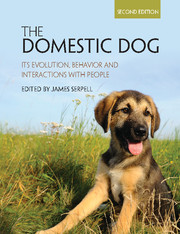Book contents
- Frontmatter
- Dedication
- Contents
- List of contributors
- 1 Introduction
- PART I ORIGINS AND EVOLUTION
- PART II BEHAVIOR, COGNITION AND TRAINING
- PART III DOG-HUMAN INTERACTIONS
- PART IV LIFE ON THE MARGINS
- 16 Variation in dog society: Between resource dispersion and social fl ux
- 17 The ecology and behavior of feral dogs: A case study from central Italy
- 18 Roaming free in the rural idyll: Dogs and their connections with wildlife
- 19 Dog population management
- 20 Epilogue: The tail of the dog
- Index
- Plate section
- References
19 - Dog population management
from PART IV - LIFE ON THE MARGINS
Published online by Cambridge University Press: 30 December 2016
- Frontmatter
- Dedication
- Contents
- List of contributors
- 1 Introduction
- PART I ORIGINS AND EVOLUTION
- PART II BEHAVIOR, COGNITION AND TRAINING
- PART III DOG-HUMAN INTERACTIONS
- PART IV LIFE ON THE MARGINS
- 16 Variation in dog society: Between resource dispersion and social fl ux
- 17 The ecology and behavior of feral dogs: A case study from central Italy
- 18 Roaming free in the rural idyll: Dogs and their connections with wildlife
- 19 Dog population management
- 20 Epilogue: The tail of the dog
- Index
- Plate section
- References
Summary
Introduction
Dogs enjoy a unique niche within a human dominated ecology. Fulfilling a range of roles, they are a part of human society around the world. There is an estimated worldwide dog population of 500–700 million distributed unevenly throughout the human population (Hughes & MacDonald, 2013; Matter & Daniels, 2000). Ratios of dogs to humans can vary from a reported 1:1.1 in the Philippines (Beran, 1982) to 1:45 in Zambia (de Balogh et al., 1993). However, for most populations the ratio is between 1:3 and 1:10 (Davlin & VonVille, 2012).
As the first species to be domesticated, dogs have developed the most intimate and complex relationship with humans (Serpell, 1996). The closeness of this relationship means that dogs are uniquely dependent on humans, with a severely limited ability to survive and reproduce in their absence (MacDonald & Carr, Chapter 16; Boitani et al., Chapter 17). It also means that they are vulnerable to any changes in this relationship that may accompany changes in human society, a notable example being urbanization. Bradshaw (2011) describes today's pet dogs as being on the verge of a crisis, struggling to meet the demands of being well-behaved urban pets when they have, until very recently, been bred for a rural working lifestyle. One consequence of urbanization, highly visible outside of Western Europe and North America, is the presence of dogs roaming on city streets, also known sometimes as stray, street or free-roaming dogs. The presence of roaming dogs can bring a range of problems, including disease risks, nuisance behaviors and welfare problems, not least through road traffic accidents. The methods used to control the population, even where efforts are made to reduce animal suffering, may also present an unacceptable situation to society. These issues, plus others, provide the motivation for humane dog population management.
The structure of the dog population is also complex. Figure 19.1, copied from ICAM Coalition (2007), illustrates the division of the population into a number of subpopulations and the routes of transition between those subpopulations. The diagram shows how a roaming dog may be a survivor of a litter born to a roaming female “on the street,” an owned dog not currently confined, or a dog that was once owned but has been abandoned.
- Type
- Chapter
- Information
- The Domestic DogIts Evolution, Behavior and Interactions with People, pp. 385 - 403Publisher: Cambridge University PressPrint publication year: 2016
References
- 2
- Cited by



